This post may contain affiliate links. Please read our disclosure policy.
This 4-ingredient fig jam recipe (fig preserves) contains just fresh figs, lemon, sugar, and walnuts (optional), with no pectin but with several flavor variations! The results are perfect for spreading over bagels, toast, adding to grilled cheese, dolloping over pizza, and more!
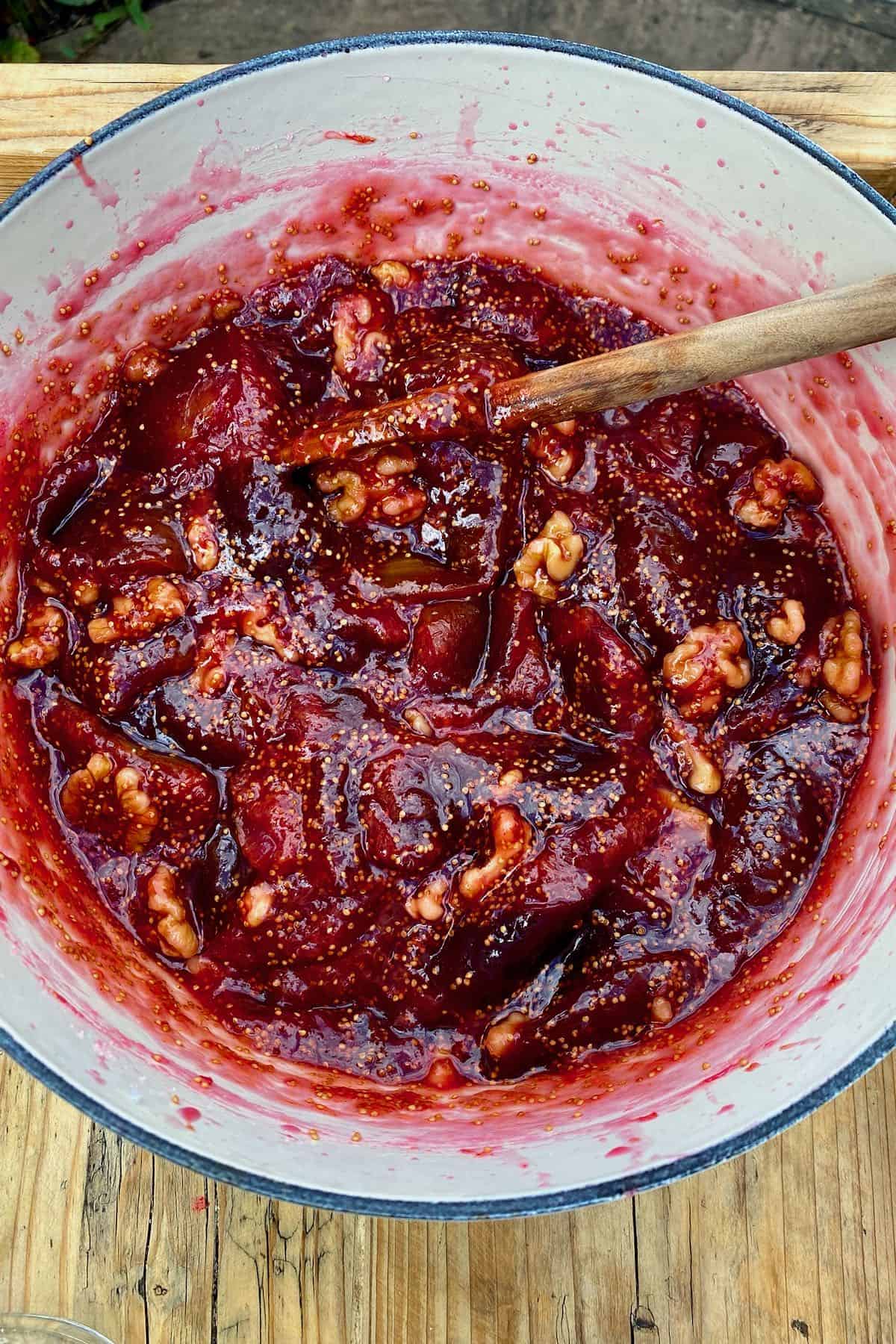
I’ve already shared strawberry, raspberry, and blackberry jam recipes with simple methods and minimal ingredients. However, this 4-ingredient fig jam recipe is even simpler. It requires just four ingredients and no pectin or complicated jam-making tools/techniques.
If you have access to a fig tree or any good source of figs, this easy fig jam is a must-try. Whether you want to make a small batch to store in the fridge or whip up a large batch for canning (long-term storage), this method has it all. Plus, unlike regular jam recipes with a 1:1 ratio of sugar to fruit, this homemade fig jam uses 1/3 the amount of sugar! And yes, the shelf life is reduced somewhat – but it’s wonderfully delicious without being cloyingly sweet!
Once prepared, store the fig jam/fig preserves unprocessed in the fridge or freezer, or water bath can it and store for up to a year! That way, you always have some to hand for everyday uses and/or quick holiday appetizers!
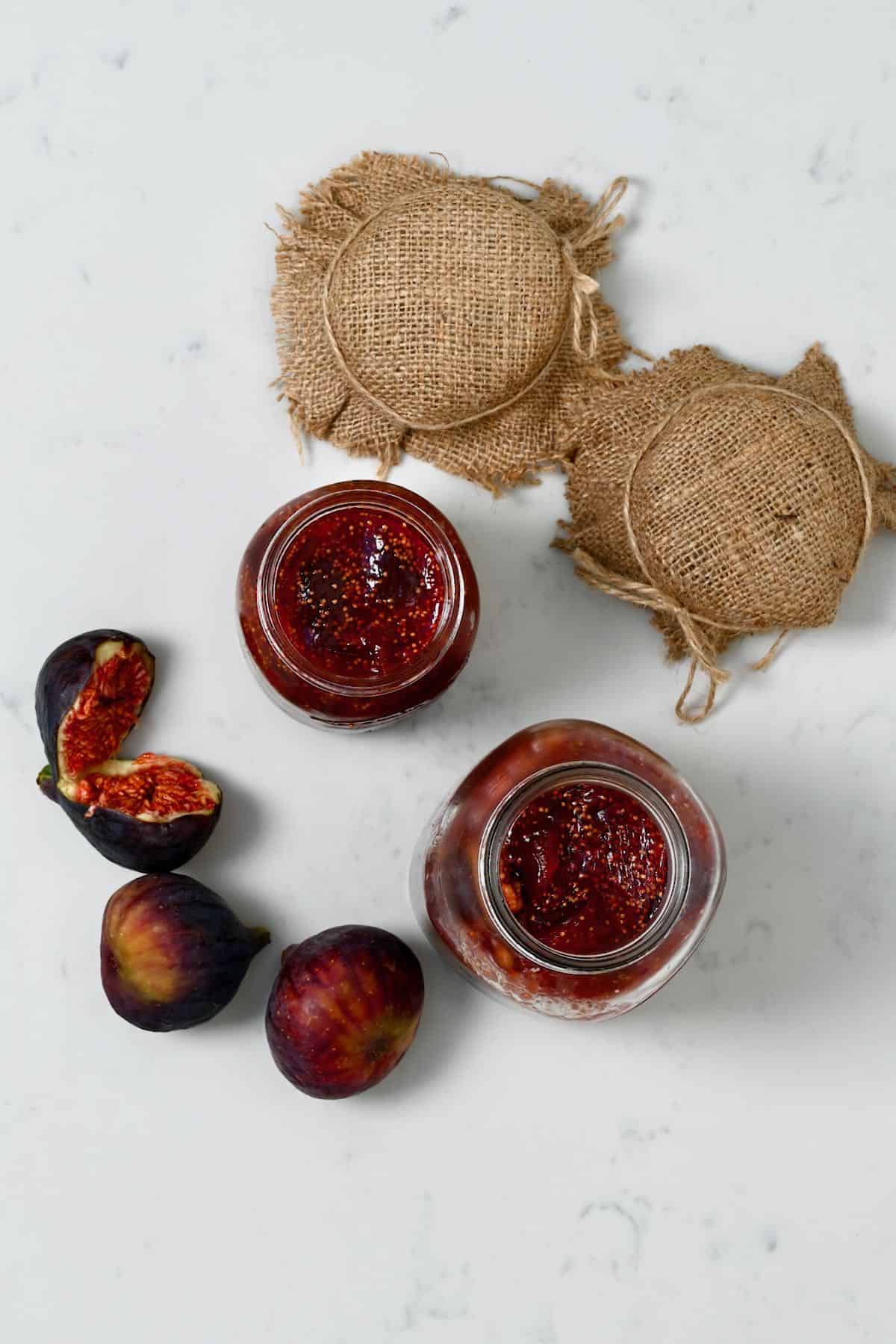
Want to save this recipe?
The Difference Between Fig Jam and Fig Preserves
Honestly, from the research that I’ve done – the two seem very similar. In fact, the only difference I’ve noted is that fig preserves are usually chunkier as they contain whole/large pieces of fruit in the mixture. In comparison, fig jam is made with mashed fruit.
However, I make this fig jam recipe quite chunky anyway. For that reason, I’ve used the terms interchangeably in this post. Let me know in the comments if there is more to the differences between the two.
For now, let’s jump right into the easy fig jam recipe. And, if you’re interested in more similar recipes, you might also like my recipes for rose petal jam and ginger marmalade!
The Fig Preserves ingredients
- Figs: use fresh ripe figs (yellow or red/purple) that are soft. I haven’t tried this recipe with green figs, though I imagine it would work. You can also use frozen (thawed) figs.
- Sugar: I used regular granulated sugar for this fig jam, so it didn’t impact the flavor too much. Alternatively, you could use another type of sugar like coconut sugar or date sugar, which will act as a natural preservative. Read FAQs regarding a sugar-free fig jam alternative.
- Lemon juice: you can use fresh or bottled lemon juice. You may be able to substitute this with apple cider vinegar, though I prefer the flavor of lemon juice. Don’t omit it entirely, as it’s needing for preserving the figs spread.
- Walnuts: while technically optionally, chopped walnuts are a popular addition to fig jam recipes in Lebanon.
- Water: if your figs are particularly juicy, you won’t need any extra water. However, if they are not, I recommend adding a little extra water (3-4 Tbsps maximum).
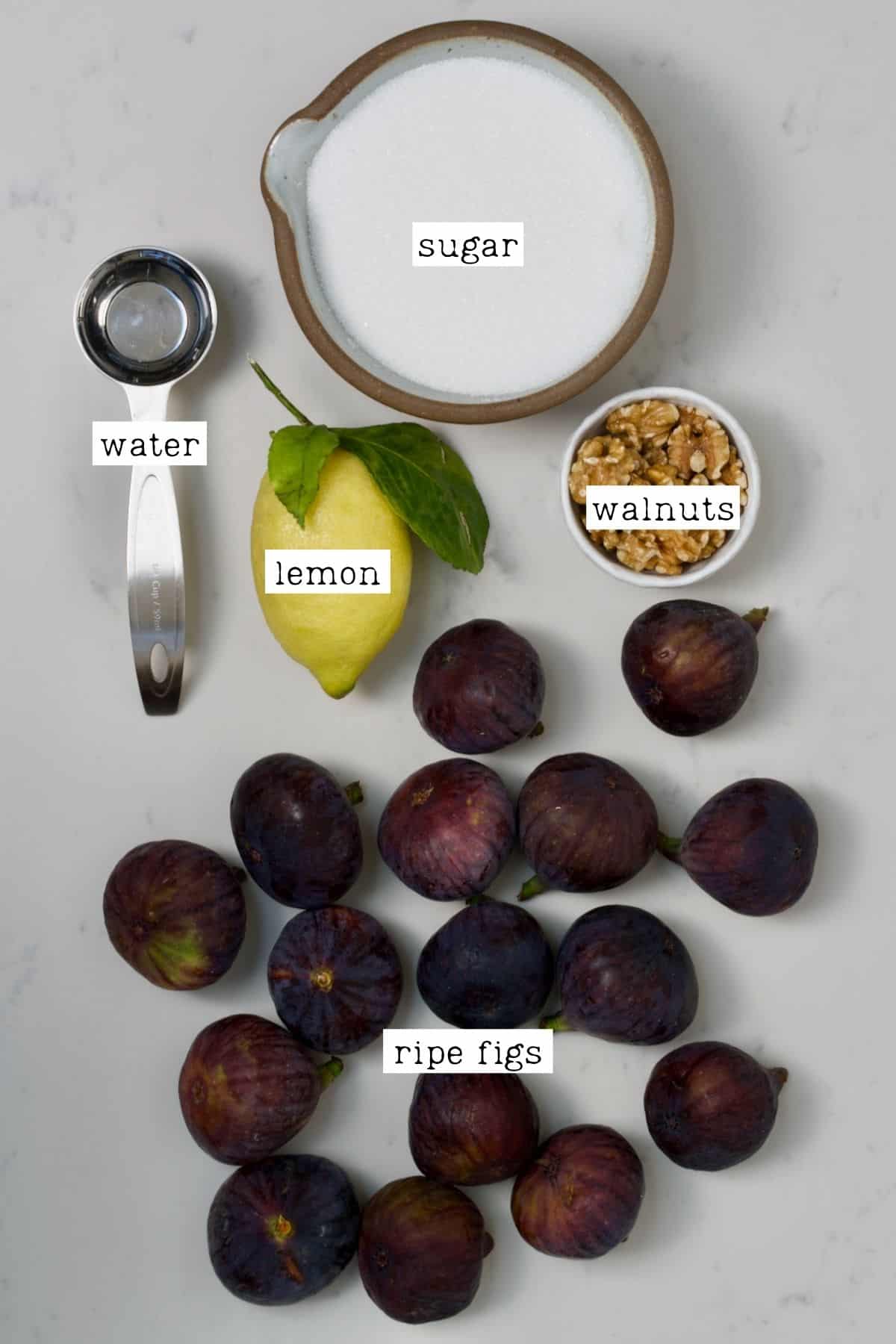
Optional Add-ins and Recipe Variations
- Rosemary/thyme: add a single sprig (around 3-4 inches long) to the saucepan. Remove it before jarring the homemade fig jam.
- Anise powder: added towards the end, to taste.
- Sesame seeds: lightly toasted – this was suggested to me by a reader.
- Vanilla: you can either add pure vanilla extract (or paste) or some vanilla powder. Do this right at the end and add to taste.
- Ginger: use finely grated ginger to taste. I recommend using ½ tsp to begin and increasing if you’d prefer a more robust flavor.
- Citrus zest: lemon or orange zest would work well in the fig preserves. I recommend using the zest from one medium lemon/orange.
- Balsamic vinegar: you can add balsamic vinegar or balsamic reduction to make an excellent fig balsamic jam. Add at the end to taste. If you add a small pinch of salt along with the balsamic, you’ll have even more depths of flavor.
- Honey: rather than replacing the sugar with honey, you can simply add a few tablespoons of honey (or vegan dandelion honey) to the mixture for flavor. Note, the darker the honey, the less you’ll need.
- Spices: you can experiment with different spices. I particularly like pairing figs with warming spices like cinnamon, cloves, cardamom, and nutmeg.
How to Make Fig Jam (Fig Preserves)
Step 1: Macerate the figs
First, wash the figs well and pat them dry with paper towels. Then slice the figs into quarters, removing any tough stems if necessary, and transfer to a large bowl. Sprinkle the sugar over the figs, mix well, and then allow the fruit to sit for at least an hour.
If you want to make a smoother fig jam, you can cut the figs into smaller pieces at this point, as it will take less time for them to break down when cooking.
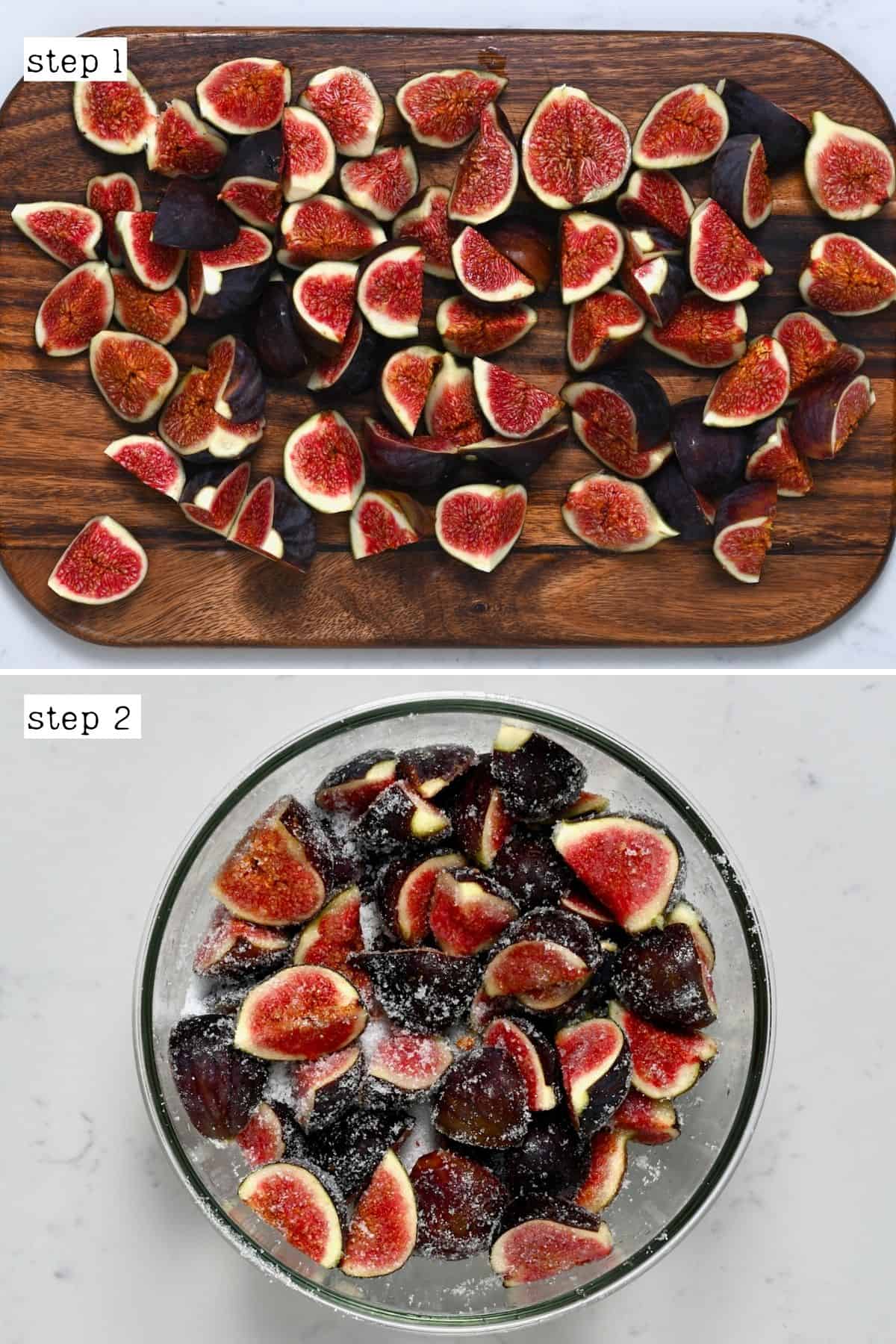
During this time, the figs will macerate, and the sugar will encourage the figs to release their juices – stir a couple of times mid-way.
Step 2: Heat the fig jam mixture
Add the macerated figs and all their juices and the lemon juice to a large pot. Heat over medium heat and stir.
If your figs aren’t very juicy, you can add a splash or two of water to the pan. The water is only needed to help dissolve the sugar, so don’t add too much as you’ll have to wait for it to reduce after.
Bring the mixture to a boil, constantly stirring until the sugar melts. Then lower the heat to medium-low. Cook, stirring occasionally, for 45-60 minutes until the fig jam has reached your desired consistency. Remember that it will thicken further as it cools. Use a spoon to gently mash the figs to your desired consistency. Towards the end of the cooking, add the roughly chopped walnuts (optional) and stir to incorporate them in the jam.
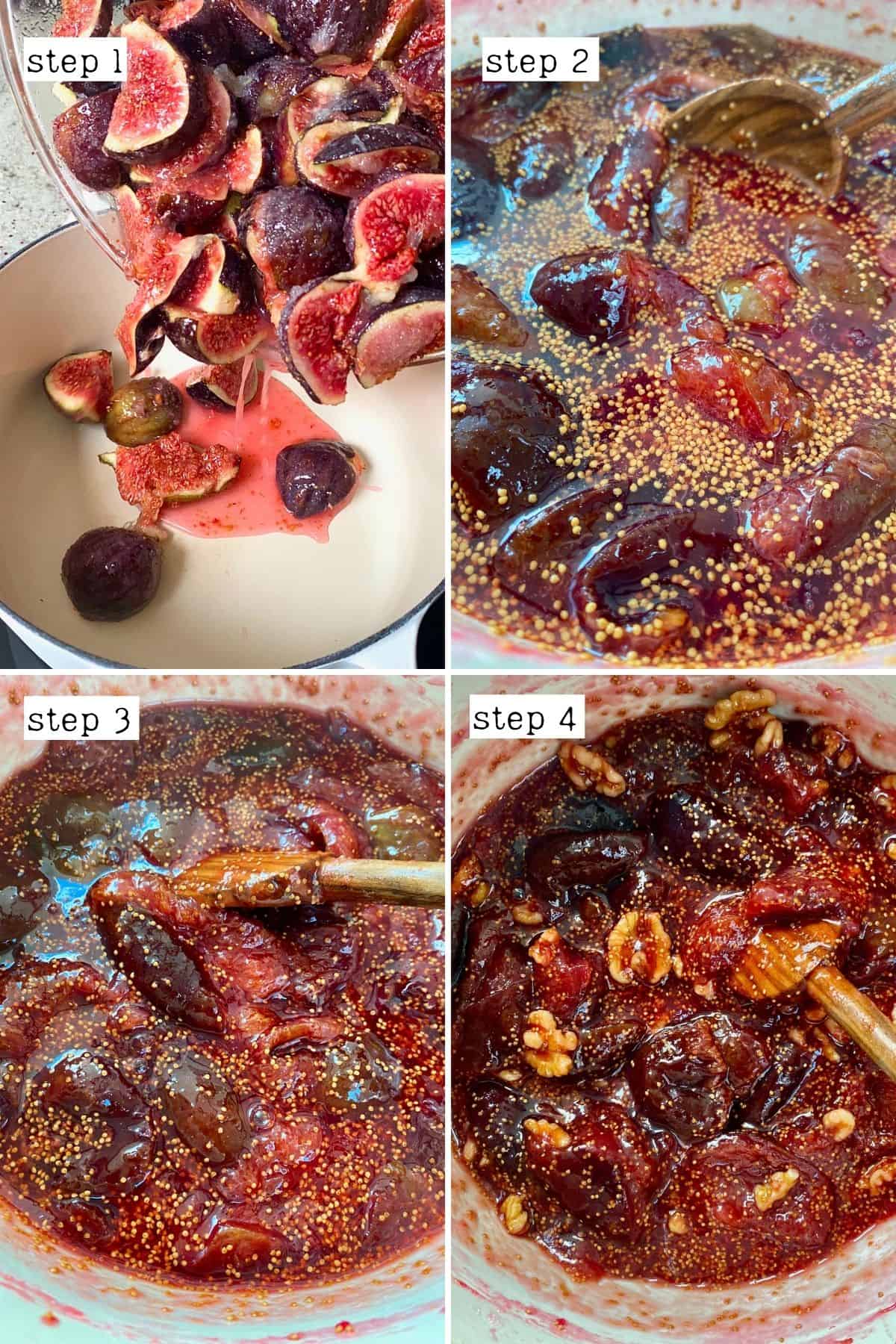
For me, the correct consistency is when the figs are all very tender, and the juices run off my spoon/spatula in heavy drops (not running). You can test this further by placing a little of the jam on a pre-chilled (in the freezer) plate. Allow it to sit for a minute, then check the consistency (this will be what it’s like when set) – it should be thick and wrinkle slightly when pushed).
If you want a smoother fig jam, you can use an immersion blender or food processor and pulse just a few times (I’d recommend doing this at the beginning of the process after the macerating step, though it can also be done at the end – just be careful since the fig mixture will be extremely hot).
Step 3: Decant the mixture
If you want to water bath can the fig jam, you’d do so now – read the FAQ section for my top tips and head over to my beginners guide to canning for all my top tips and the method.
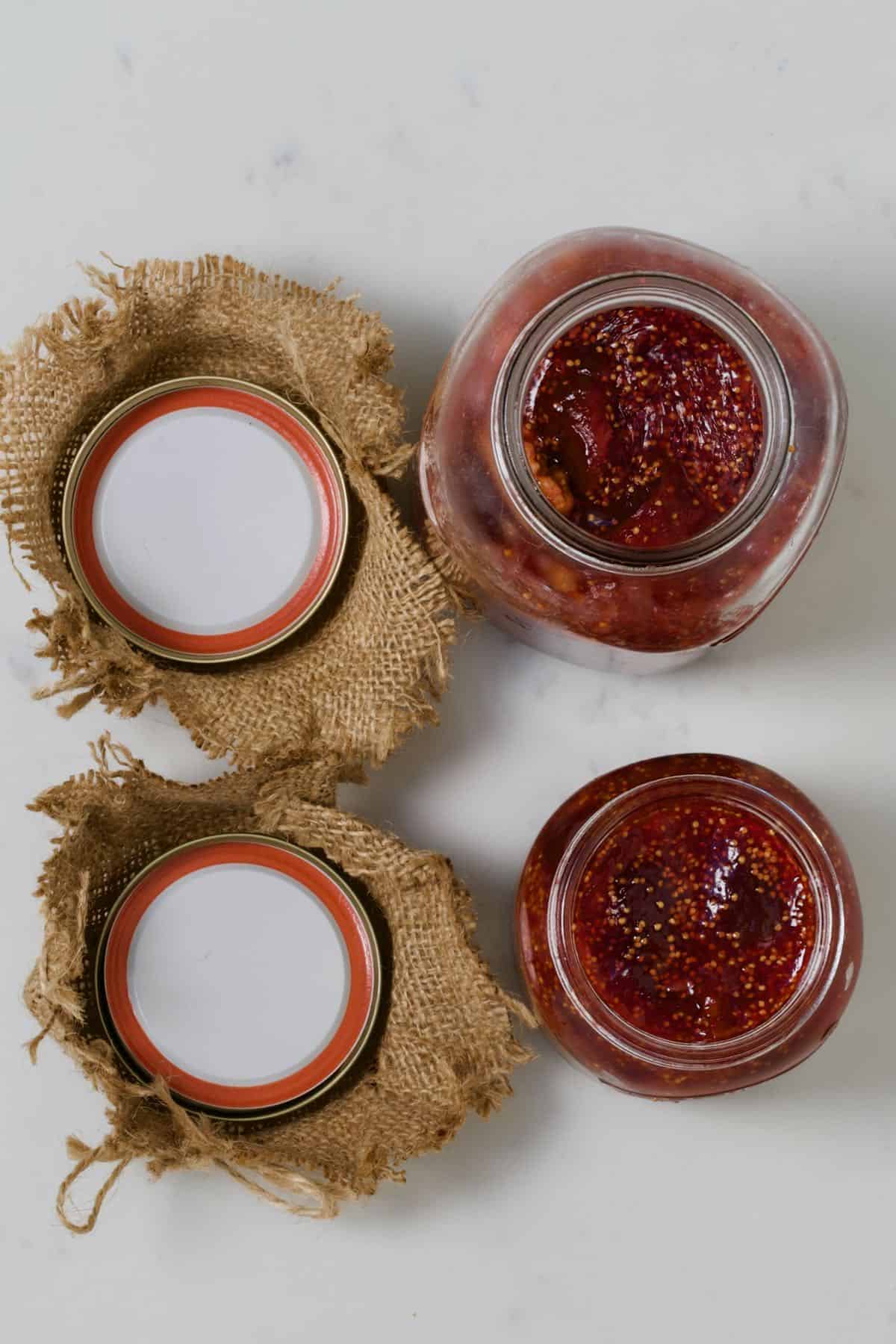
Alternatively, transfer the hot fig jam to your sterilized jars, allow it to cool for a short while with the lids finger-tight. Then fully close the lid and transfer to the fridge.
Fig Jam Uses
There are tons of ways to enjoy the fig jam, including:
- As part of a cheese platter/charcuterie board.
- As a fig spread for over a grilled cheese sandwich or other sandwiches.
- Figs spread over bagels, toast, simit, etc.
- Added to burgers.
- Use as a glaze (combined 50/50 with water) for proteins.
- Thin with water to use as a sauce.
- Use as a pizza topping.
- Spoon into oatmeal or overnight oats.
- Add to yogurt bowls (dairy or coconut yogurt) with fruit and granola.
- Use for holiday appetizers like baked brie and fig jam or fig jam goats cheese appetizer.
Let me know in the comments how you best enjoy this fig jam/fig preserve.
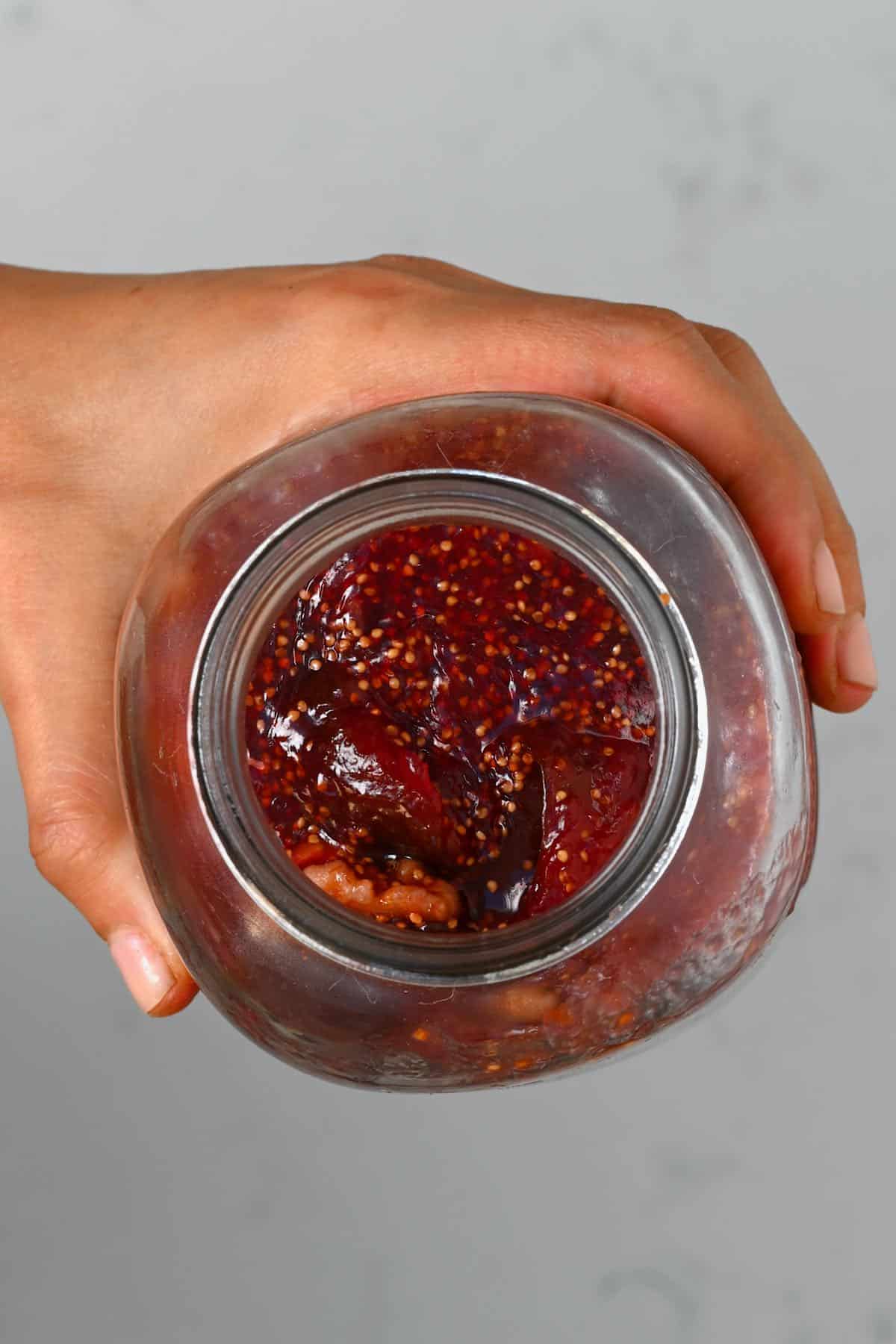
How to Store Fig Jam
The storing methods will differ based on whether you’re storing the fig jam as-is without canning or if it’s been canned.
Storing: you can store the fig jam in the fridge for 2-3 weeks (it may last longer, but I always use mine within 2 weeks, so I can’t guarantee it). Alternatively, transfer it to the freezer for 2-3 months (in a jar with 1-inch headspace).
Canned: once processed and left to cool, the fig jam is now shelf-stable and can be stored in a cool dark location for up to 10-12 months (as it has less sugar). If you increase the sugar, it will last up to two years.
FAQs
No, there’s no need to peel the figs unless they are really tough. Otherwise, they will soften wonderfully during the cooking process.
Yes, but be aware that the shelf life will be impacted, and the jam won’t be as thick – so you may want to add a little pectin for a harder set. To make a sugar-free version, you can use your favorite sweetener: stevia, erythritol, monk fruit sugar, etc. added, to taste.
Note – lemon peel has natural pectin and can be added to the jam in long strips that are removed before it’s moved to the jars OR use finely grated lemon zest to leave in the fig jam.
If you wanted to use maple syrup or honey, then that would work. However, it won’t help with the thickening in the same way that granulated sugar does. In that case, you can either enjoy your figs spread as a thinner consistency or add a little pectin to it.
With most liquid sweeteners, you’ll also want to add a smaller amount than the granulated sugar (I recommend half to begin, then increasing to taste). I prefer using a combination of regular granulated and liquid (like honey) – so the liquid sweetener doesn’t overpower the flavor of the figs.
Yes, you can. You can read my beginner’s canning guide for all my top tips and method for canning. For this homemade fig jam, I recommend leaving ½-inch headspace and processing the jars for 10 minutes (adjust based on the altitude).
However, it’s worth noting that the pH level of figs is right around the 4.6 required for canning, so even with the lemon juice – if you want to be sure that it is safe for canning, you can use a pH strip to test the mixture.
I don’t see why not as long as you reconstitute them first. The texture of the dried fig jam won’t be exactly the same, though. Let me know if you try it in the comments.
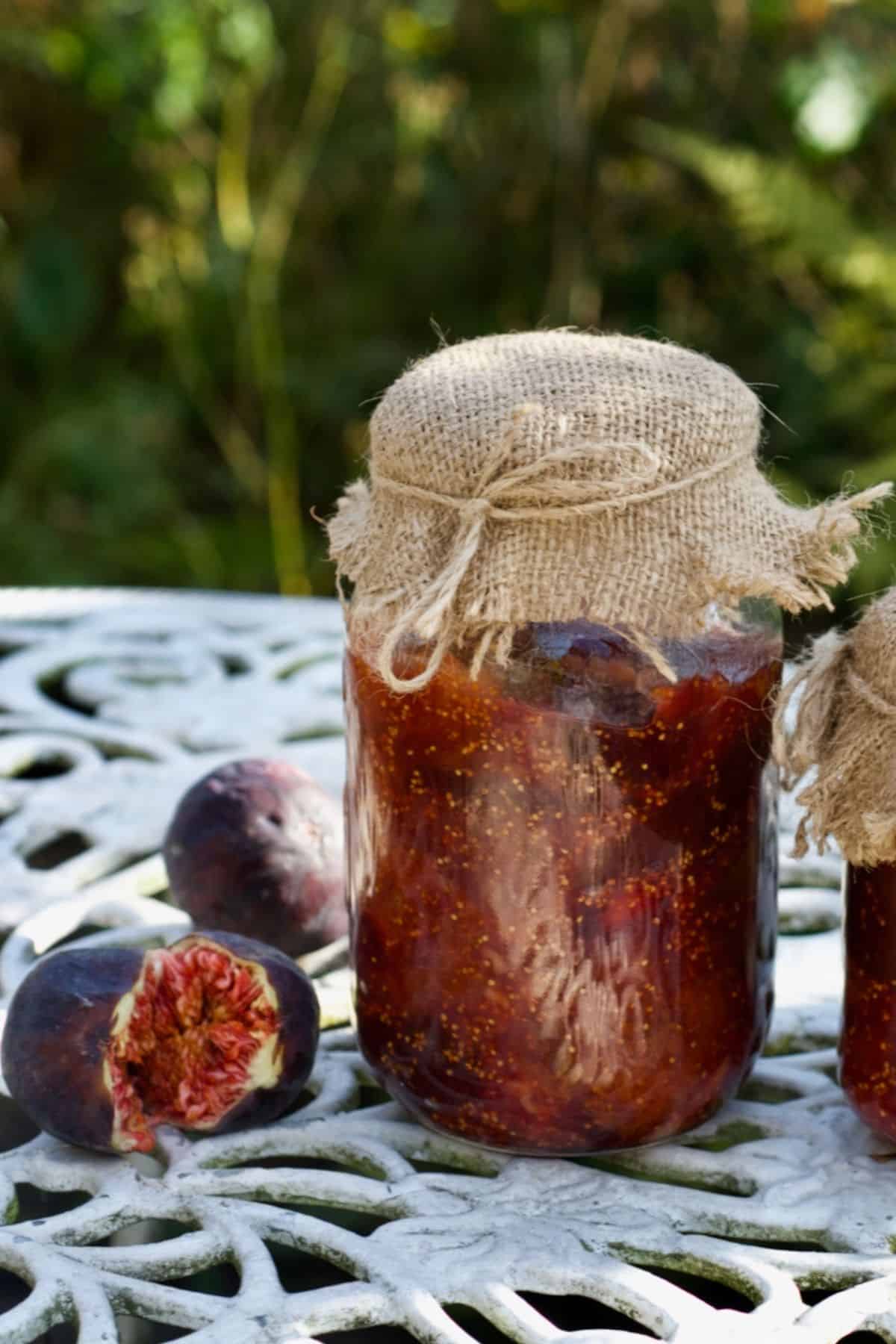
Recipe Notes and Top Tips
- Use nonreactive tools: this includes a nonreactive saucepan (stainless steel, glass, enamel-coated will work well), spoons (silicone or wooden), etc. Avoid aluminum, copper, etc.
- Use a deep pot: another good tip is to use a deep pot, preferably one with a lid – as this jam likes to spit in the first part of its boiling process.
- If you over-cook the fig jam: it can become very solid as it’s overset. However, don’t worry – I’ve heard that this can be fixed by re-heating the mixture with additional water and lemon juice.
- For a good gel: the aim is to cook the fig jam to 220ºF/105ºC to reach the good gel stage. However, if you don’t have a thermometer – you can follow the method above – testing the consistency with the spoon and plate methods.
- If your fig jam is too runny: there are several reasons this might be. If you’ve reduced the amount of sugar, this will impact the texture. Also, if the jam didn’t reach 220ºF/105ºC – the optimal “setting” temperature. If you find it too thin even after chilling, you can return it to a pan and cook for longer.
- Adjust the texture: if you want a thicker fig preserve texture with large pieces of fig within, add water to the pan, and be careful when mixing with the wooden spoon, so you don’t break up the fruits too much. For a less chunky mixture, use your spoon to gently mash the figs as they cook. For smooth fig jam, you can process the mixture either before or after it’s cooked (using an immersion blender or regular blender).
- Make sure to use sterilized jars: whether or not you plan on water bath canning the jam, ensure you use sterilized jars for the best shelf life.
- Adding water to the recipe: only add water if the figs aren’t very juicy – otherwise, it will take longer to reduce the mixture again. I added no water to this recipe since my figs were so juicy.
More Simple DIYs
If you try this simple fig jam recipe, I’d love to hear your thoughts and questions below. Also, I’d appreciate a recipe card rating below, and feel free to tag me in your recipe recreations on Instagram @Alphafoodie!
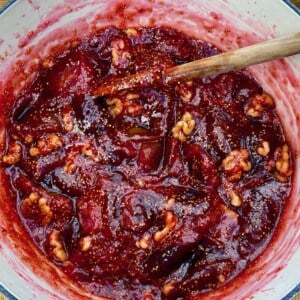
Simple Fig Jam Recipe (Fig Preserves – No Pectin)
Equipment
Ingredients
- 3.3 lb ripe figs red or yellow-fleshed figs will work; frozen (thawed) will also work
- 1.1 lb sugar or coconut sugar or brown sugar; check FAQs for sugar-free notes
- 3 Tbsp lemon juice 1 large lemon; or apple cider vinegar
- 1/4 cups walnuts optional
- 3-4 Tbsp water may be needed (notes in recipe)
Check the Recipe Notes below for optional add-ins and variations to the recipe!
Instructions
Step 1: Macerate the figs
- Wash the figs well and pat them dry with paper towels. Then slice the figs into quarters, removing any tough stems if necessary.
- Transfer them to a large bowl. Sprinkle the sugar over the figs, mix well, and then allow the fruit to sit for at least an hour.If you want to make a smoother fig jam, you can cut the figs into smaller pieces at this point, as it will take less time for them to break down when cooking.During this time, the figs will macerate, and the sugar will encourage the figs to release their juices – stir a couple of times mid-way.
Step 2: Heat the fig jam mixture
- Add the macerated figs and all their juices and the lemon juice to a large pot. Heat over medium heat and stir.If your figs aren’t very juicy, you can add a splash or two of water to the pan. The water is only needed to help dissolve the sugar, so don't add too much as you'll have to wait for it to reduce after.
- Bring the mixture to a boil, constantly stirring until the sugar melts. Then lower the heat to medium-low. Cook, stirring occasionally, for 45-60 minutes until the fig jam has reached your desired consistency. Remember that it will thicken further as it cools. Use a spoon to gently mash the figs to your desired consistency. Towards the end of the cooking, add the roughly chopped walnuts (optional) and stir to incorporate them in the jam.For me, the correct consistency is when the figs are all very tender, and the juices run off my spoon/spatula in heavy drops (not running). You can test this further by placing a little of the jam on a pre-chilled (in the freezer) plate. Allow it to sit for a minute, then check the consistency (this will be what it’s like when set) – it should be thick and wrinkle slightly when pushed).
- If you want a smoother fig jam, you can use an immersion blender or food processor and pulse just a few times (I'd recommend doing this at the beginning of the process after the macerating step, though it can also be done at the end – just be careful since the fig mixture will be extremely hot).
Step 3: Decant the mixture
- If you want to water bath can the fig jam, you'd do so now – read the FAQ section for my top tips and head over to my beginners guide to canning for all my top tips and the method. Alternatively, transfer the hot fig jam to your sterilized jars, allow it to cool for a short while with the lids finger-tight. Then fully close the lid and transfer to the fridge.
How to Store Fig Jam
- The storing methods will differ based on whether you're storing the fig jam as-is without canning or if it's been canned.Storing: you can store the fig jam in the fridge for 2-3 weeks (it may last longer, but I always use mine within 2 weeks, so I can't guarantee it). Alternatively, transfer it to the freezer for 2-3 months (in a jar with 1-inch headspace).Canned: once processed and left to cool, the fig jam is now shelf-stable and can be stored in a cool dark location for up to 10-12 months (as it has less sugar). If you increase the sugar, it will last up to two years.
Video
Notes
- Use nonreactive tools: this includes a nonreactive saucepan (stainless steel, glass, enamel-coated will work well), spoons (silicone or wooden), etc. Avoid aluminum, copper, etc.
- Use a deep pot: another good tip is to use a deep pot, preferably one with a lid – as this jam likes to spit in the first part of its boiling process.
- If you over-cook the fig jam: it can become very solid as it’s overset. However, don’t worry – I’ve heard that this can be fixed by re-heating the mixture with additional water and lemon juice.
- For a good gel: the aim is to cook the fig jam to 220ºF/105ºC to reach the good gel stage. However, if you don’t have a thermometer – you can follow the method above – testing the consistency with the spoon and plate methods.
- If your fig jam is too runny: there are several reasons this might be. If you’ve reduced the amount of sugar, this will impact the texture. Also, if the jam didn’t reach 220ºF/105ºC – the optimal “setting” temperature. If you find it too thin even after chilling, you can return it to a pan and cook for longer.
- Adjust the texture: if you want a thicker fig preserve texture with large pieces of fig within, add water to the pan, and be careful when mixing with the wooden spoon, so you don’t break up the fruits too much. For a less chunky mixture, use your spoon to gently mash the figs as they cook. For smooth fig jam, you can process the mixture either before or after it’s cooked (using an immersion blender or regular blender).
- Make sure to use sterilized jars: whether or not you plan on water bath canning the jam, ensure you use sterilized jars for the best shelf life.
- Adding water to the recipe: only add water if the figs aren’t very juicy – otherwise, it will take longer to reduce the mixture again. I added no water to this recipe since my figs were so juicy.
- Rosemary/thyme: add a single sprig (around 3-4 inches long) to the saucepan. Remove it before jarring the homemade fig jam.
- Anise powder: added towards the end, to taste.
- Sesame seeds: lightly toasted – this was suggested to me by a reader.
- Vanilla: you can either add pure vanilla extract (or paste) or some vanilla powder. Do this right at the end and add to taste.
- Ginger: use finely grated ginger to taste. I recommend using ½ tsp to begin and increasing if you’d prefer a more robust flavor.
- Citrus zest: lemon or orange zest would work well in the fig preserves. I recommend using the zest from one medium lemon/orange.
- Balsamic vinegar: you can add balsamic vinegar or balsamic reduction to make an excellent fig balsamic jam. Add at the end to taste. If you add a small pinch of salt along with the balsamic, you’ll have even more depths of flavor.
- Honey: rather than replacing the sugar with honey, you can simply add a few tablespoons of honey to the mixture for flavor. Note, the darker the honey, the less you’ll need.
- Spices: you can experiment with different spices. I particularly like pairing figs with warming spices like cinnamon, cloves, cardamom, and nutmeg.
Nutrition
Nutrition information is automatically calculated, so should only be used as an approximation.

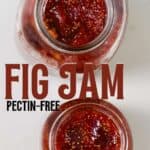

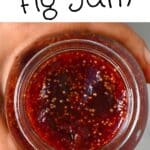


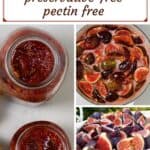
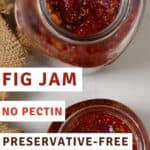

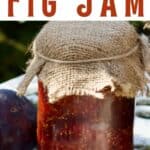
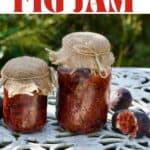
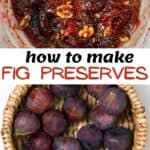









How many jars will this make for canning?
Hi Jill,
For me it yielded about 5 cups (40 oz). How many jars you need will depend on their size. For example, you would need 4 jars of 10 oz each. I hope this helps.
Delicious. Thank you for sharing your recipe.
Glad you liked it, Sonnia! 🙂